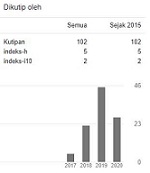INFORMATION GAP ACTIVITIES TO IMPROVE STUDENTS’ ORAL PROFICIENCY AT PKBM CANDRA KIRANA
Abstract
Keywords
References
Breg, Bruce L. 1989. Qualitative
Research Method for the
Social Society. United State:
Allyn & Bacon.
Brumfit, C.J. and K. Johson. 1983.
Communicative Approach to
Language Teaching.
Oxford: Oxford University
Press.
Burns, A and Joyce, H. 1997. Focus
on Speaking. Sydney:
National Center for English
Language Teaching and
Research.
Ground Land, Norman E. 1985.
Stating Objectives for Classroom
Instruction. New York.: Macmilan
Publishing.
Hadi, Sutrisno. 1986. Methodology
Research 2: Jogjakarta.
Litlewood, William. 1983. Communicative
Language Teaching.: An
Introduction. Cambridge:
Cambridge University Press.
Lubis, Yusnaeni, 1988: Developing
Communicative Proficiency In The
English As a Foreign Language
Classroom. Jakarta: Depdikbud.
Renandya, Willy. Second Language
Acquisition Principles and
Technology to Improve Oral’s
Proficiency. 2020. Singapore
University Press.
Richards, Jack c and Theodore S. Rodgers.
Approaches and Methods in
Language Teaching. As Description
and Analysis. Cambridge:
Cambridge University Press.
Savignon, Sandra J. 1983. Communicative
Competence Theory and Classroom
Practice. Massachusset: Addison,
Wesley Publishing Company.
Saukah, Ali and Mardibyo, 1995. English
for High School. Jakarta:
Depdikbud.
Sy, Evha Nazalatus Sa’adiyah and
Yuliarsih. 2019. SELL Journal, 4
(2), 123-130
Syllabus, 2013. English Curriculum.
Ur, P. (1996). A Course in Language
Teaching: Practise and Theory.
Cambridge: Cambridge University
Press
DOI: 10.53712/ellite.v4i1.1041
Refbacks
- There are currently no refbacks.







